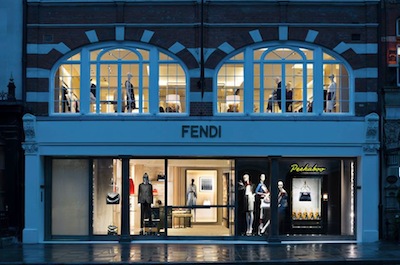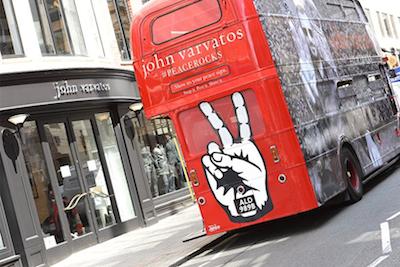 Naomi Campbell for Burberry, holiday 2015
Naomi Campbell for Burberry, holiday 2015
London is home to more luxury retailers than any other European city, making the capital of the United Kingdom attractive for brands looking to cement a bricks-and-mortar presence in a strong market.
The "London Luxury Quarter -- Global Destination Appeal" report, conceived by Heart of London Business Alliance and New West End Company and commissioned by JLL, appraises London’s prowess as a global destination with a flow of foreign visitors spending an estimate of $6.9 billion per year. While international markets are constantly evolving, London’s high streets have matured into a luxury destination offering affluent consumers a unique take on heritage, DNA and offerings.
“Despite a slowing growth in the global digital market, thanks to its broad mixed use makeup and destination appeal, London Luxury Quarter remains the epitome of resilience,” said Guy Grainger, UK CEO of JLL, London.
“Consumers continue to flock to the Quarter’s unrivaled offer and heritage, and visitor numbers will be boosted further by positive demographic forces, improved connectivity and world class developments,” he said.
“On the proviso that the area continues to evolve and grow, it is our view that success will breed further success for London Luxury Quarter.”
The London Luxury Quarter looks at London over the course of the last three years as a followup to a report of the same title from 2012. The report charts London Luxury Quarter’s recent fortunes and identifies challenges and opportunities for future growth.
London calling
London’s high streets, bundled together to create the London Luxury Quarter, feature more than 1,000 businesses housed on more than 65 streets and arcades. The area’s retail and leisure space totals approximately 6 million square feet, giving brands ample room to establish a strong market presence.
In terms of brands, the London Luxury Quarter offers consumers physical access to more than 70 percent of the world’s top 100 luxury brands. The Quarter is also home to more than 67 percent of all jewelry retailers in London’s West End, occupying about 130,000 square feet of retail space.
The area is home to more than 100 art galleries, including the Royal Academy of Arts, 17 five-star hotels in Mayfair and St. James, 23 restaurants with 31 Michelin stars between them and 45 private member clubs.
The Quarter’s retail sales growth is also the strongest in Western Europe, forecasted to increase 3.8 percent.
International sales picked up in 2015 after transactions decreased in 2014 due to international unrest and legislation limiting Chinese spending and currency fluctuations, among other external factors. 2015 saw growth of 5 percent in the first half of the year, driven by an 11 percent increase on average spending.
Likewise, growth has been propelled by international tourists from China and the Middle East.
Due to relaxed travel visas, consumers from Saudi Arabia were responsible for 31 percent of total sales, while Qatar attributed 18 percent. A similar process for Chinese consumers has also helped to increase the sales from China.
 Fendi on Bond Street, London
The capital is also appealing for luxury brands, as the market is sizable, mature and offers a high degree of transparency, which contributes to a long history of success for international and luxury retailers.
Bond Street, London’s most prestigious high street, for instance, has the second highest rent in Europe, behind Paris’ Champs Élysées. Comprising both Old and New Bond Street, the retail avenue successfully combines flagship boutiques, exclusive brands, designer fashion, luxury goods, jewelry, galleries and antiques, making for a competitive rental real estate market.
Fendi on Bond Street, London
The capital is also appealing for luxury brands, as the market is sizable, mature and offers a high degree of transparency, which contributes to a long history of success for international and luxury retailers.
Bond Street, London’s most prestigious high street, for instance, has the second highest rent in Europe, behind Paris’ Champs Élysées. Comprising both Old and New Bond Street, the retail avenue successfully combines flagship boutiques, exclusive brands, designer fashion, luxury goods, jewelry, galleries and antiques, making for a competitive rental real estate market.
 John Varvatos recently entered the London market
Beyond Bond Street, the London Luxury Quarter is seeing growth beyond its traditional boundaries. Brands are looking to retail stretches such as Mount, Dover and Bruton Streets to find buildings that accurately reflect their unique message.
Development of Duke Street, for example, has attracted a number of high-end brands and successfully links Mount and Oxford Streets and nearby department store Selfridges. The ripple effect away from Bond Street has stretched to Albemarle Street, Conduit Street and Savile Row, known for its traditional bespoke tailoring around the world.
London is also an attractive destination for international travelers with 18.8 million visitors each year. London Luxury Quarter offers these travelers more than 40 of the city’s leading hotels, including Claridge’s, The Connaught, The Ritz London, The Langham and a number of others.
John Varvatos recently entered the London market
Beyond Bond Street, the London Luxury Quarter is seeing growth beyond its traditional boundaries. Brands are looking to retail stretches such as Mount, Dover and Bruton Streets to find buildings that accurately reflect their unique message.
Development of Duke Street, for example, has attracted a number of high-end brands and successfully links Mount and Oxford Streets and nearby department store Selfridges. The ripple effect away from Bond Street has stretched to Albemarle Street, Conduit Street and Savile Row, known for its traditional bespoke tailoring around the world.
London is also an attractive destination for international travelers with 18.8 million visitors each year. London Luxury Quarter offers these travelers more than 40 of the city’s leading hotels, including Claridge’s, The Connaught, The Ritz London, The Langham and a number of others.
 Mandarin Oriental Hyde Park
For the fifth consecutive year, revenue per vacant room at London hotels grew 3.3 percent to $165. The occupancy rate rose to 83 percent, the highest across Europe, with approximately $5.50 added to average room rates, close to $199 at the end of 2015.
Raising costs
Recently, there has been an increase in overseas investors purchasing retail real estate in London’s Luxury Quarter, many of whom are from Asia. London’s real estate market is considered a “safe haven and [a] fair value” in comparison to their home markets, in addition to the bonus of favorable exchange rates, high rents and lower taxes.
According to a recent report by Cushman & Wakefield, London’s New Bond Street yields rents of $1,321 per square foot per year (see story), for example. Whereas, rents on New York's Fifth Avenue exceed $5,000 per square foot and Hong Kong's Causeway Bay sees rents of $2,399.
London has seen staggering growth in terms of retail real estate, but competition for bricks-and-mortar space and consumer interest in ecommerce presents challenges. Research by Technavio suggests that by 2019, the luxury online retail market will reach $41.8 billion (see story), which may turn London Luxury Quarter’s active presence into more of a showrooming atmosphere.
“Occupiers continue to seek space within the area, and despite the threat of rising occupancy costs, this demand shows no sign of abating,” Mr. Grainger said. “And investors continue to dig even deeper to secure real estate ownership within the Quarter.”
Mandarin Oriental Hyde Park
For the fifth consecutive year, revenue per vacant room at London hotels grew 3.3 percent to $165. The occupancy rate rose to 83 percent, the highest across Europe, with approximately $5.50 added to average room rates, close to $199 at the end of 2015.
Raising costs
Recently, there has been an increase in overseas investors purchasing retail real estate in London’s Luxury Quarter, many of whom are from Asia. London’s real estate market is considered a “safe haven and [a] fair value” in comparison to their home markets, in addition to the bonus of favorable exchange rates, high rents and lower taxes.
According to a recent report by Cushman & Wakefield, London’s New Bond Street yields rents of $1,321 per square foot per year (see story), for example. Whereas, rents on New York's Fifth Avenue exceed $5,000 per square foot and Hong Kong's Causeway Bay sees rents of $2,399.
London has seen staggering growth in terms of retail real estate, but competition for bricks-and-mortar space and consumer interest in ecommerce presents challenges. Research by Technavio suggests that by 2019, the luxury online retail market will reach $41.8 billion (see story), which may turn London Luxury Quarter’s active presence into more of a showrooming atmosphere.
“Occupiers continue to seek space within the area, and despite the threat of rising occupancy costs, this demand shows no sign of abating,” Mr. Grainger said. “And investors continue to dig even deeper to secure real estate ownership within the Quarter.”
